whole-house
Whole-House Water Filter System Catalytic Carbon 1.5 CU FT AQT-56FT
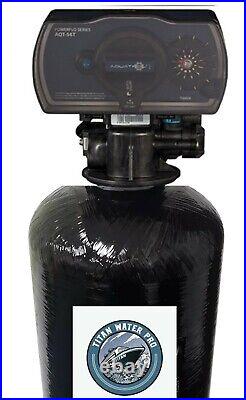

Whole House Water Filter System 1.5. CU FT Catalytic Carbon with Aquatrol FT56 Backwash Valve. WHOLE HOUSE WATER FILTER. Whole-House Filter or Point of Entry. A whole-house filter is installed at a point on the home’s water supply plumbing that will result in treatment of all water that travels to any faucet or fixture in the home. A whole-house filter system treats all water traveling to any faucet or fixture in the home. It removes the chemical before it can be ingested, breathed in, or absorbed by the skin during washing or bathing. Catalytic Carbon high activity granular activated carbon manufactured by steam activation of select coconut shell charcoal. The Catalytic activity of this activated carbon makes it highly effective for the removal of chloramines from potable water. Its large micropore volume makes it particularly well suited for the removal low molecular weight organic compounds and their chlorinate by-products such as chloroform and other trihalomethanes (THMs). An important feature of this material is its superior mechanical hardness and extensive dedusting during its manufacture ensures an exceptionally clean activated carbon product. Residential and Commercial Water Filters. One of the key characteristics of activated carbon is not only the high surface area available relative to their mass, but also the ability to act as a substrate for other materials. Activated carbons are carefully engineered to have the correct physical properties to optimize their use in this duty, manufactured from coconut shell, coal or wood bases. Many water utilities across the U. Are transitioning to chloramine for disinfection as an alternative to chlorine. This change is in response to stricter U. Environmental Protection Agency regulations on disinfection byproducts (DBPs), which are created when chlorine reacts with organics in water. Chloramine, a combination of chlorine and ammonia, is more stable and does not create DPBs. Removing chloramine at the point of use, however, is more difficult than removing chlorine. Standard granular activated carbon (GAC) and carbon gac products have limited capacity for chloramine reduction. Products known as “catalytic” or “surface-modified” activated carbon can provide a solution. In general, the catalytic properties of carbon are measured by the rate at which carbon decomposes hydrogen peroxide. The resulting peroxide number, measured in minutes, estimates the carbon’s utility in any catalytic application, including chloramine reduction. Based on the comparative results obtained for different mesh size commercial carbons, the efficiency of chloramine reduction is discussed in the terms of peroxide decomposition capacity and further extended to the total life (volume) claims for corresponding GAC carbon. Chemistry of Iron Oxidation. A mineral found in soil, iron normally exists in an insoluble oxide form, namely ferric oxide. If acidic or carbon dioxide containing water passes through the soil, the insoluble ferric oxide is reduced to the very soluble ferrous form. When water is pumped from the ground, oxygen from air enters the water and is available for reaction with the ferrous iron. In the presence of oxygen the ferrous form is eventually oxidized to the insoluble ferric form, resulting in familiar red deposits that stain sinks and clothes. In iron removal processes, the insoluble ferric hydroxide comes out of solution and is separated from the water by either filtration or settling. Catalytic carbon accelerates the reaction rate of ferrous to ferric iron dramatically, completely removing the in the relatively short time the water is in contact with the carbon. Under normal conditions, the reaction rate of ferrous to ferric iron is fairly slow, even when excess oxygen is present. This slow reaction rate necessitates the use of large retention tank and sedimentation tanks to allow time for precipitation to occur. A separate filtration step is then required to remove the remaining particulate. In treating iron-laden water, the catalytic properties of the form of granular activated carbon perform quite differently from standard activated carbon. The catalytic properties greatly accelerates the reaction time of iron to an insoluble form. By oxidizing iron from a soluble to less soluble state, catalytic carbon serves to simplify the removal. The resultant increase in reaction rate that occurs by using catalytic carbon allows smaller pieces of equipment to be used. As with all oxidation techniques, oxygen is required but a simple eductor or air injection pump is all that is required. As the reaction occurs, the precipitate is collected on the surface of the carbon, and a secondary filter is not required. Periodic backwashing is performed to remove this iron floc and return the carbon to a usable state. Another benefit of the catalytic carbon is its proven performance in removing hydrogen sulfide (H2S) from water. Many iron-containing waters also contain H2S and same bed of catalytic carbon can be used to remove both. Similarly, the unique reactive nature of the internal surface of activated carbon means that there is an inherent ability for the promotion of reactions between gases and liquids that would either proceed too slowly or generate uneconomic yields of final product. This is achieved without the need for the addition of a chemical reagent to the activated carbon and often true catalysis proceeds, without degradation of the surface or adsorbent. Whole House Water Filtration. This unit includes the following. 1054 FRP Mineral Tank (Color Varies). Aquatrol 56FT Auto Timer Valve 110V -1 Yoke. Catalytic Carbon 1.5 Cu Ft. Good Economical Whole House Catalytic Carbon Water Filter System. Hydrogen sulfide concentrations exceeding 7 to 10 ppm can be removed by injecting an oxidizing chemical such as household bleach followed up by filtration. The oxidizing chemical should enter the water upstream from the storage or mixing tank to provide at least 30-45 minutes of contact time between the chemical and water. The length of length of the holding time is a function of the chemical dosage, tank configuration and water temperature. Sulfur particles can then be removed using a sediment filter and the excess chlorine can be removed by activated carbon filtration. If test results indicate that bacterial contamination is occurring, shock chlorination or disinfection is the most widely suggested method for initial treatment. Shock chlorination (disinfection) is the one-time introduction of a strong solution into the entire water distribution system well, pump, distribution pipeline, etc. When to Shock Disinfect the Well. Shock chlorination (disinfection) is recommended when lab results indicate a presence of bacteria upon completion of a new well or after pump replacement or repair, when the distribution system is opened for repairs or maintenance, following contamination by flood water, to control iron and sulfur bacteria. Shock chlorination (disinfection) is recommended in these circumstances to ensure that bacterial contamination is controlled. This system should be used where low to moderate ferrous (dissolved) iron or hydrogen sulfide contamination is known. This filter is most effective where iron and hydrogen sulfide levels are less then 5 ppm. Best removal rates are achieved where pH is between 6.5 and 8.5 and where water contains some dissolved oxygen. Selecting a water treatment system begins with water test results from a certified drinking water testing lab. Such test results should be compared to the water treatment product specifications to ensure that the treatment system being considered is designed to treat. The substances you want to treat. In the concentrations at which they exist in your water. There is no one-size-fits-all water treatment technology that addresses all water quality problems. In some cases, one treatment technology may meet all your specific needs. In other cases, you may need a “treatment train”-a series of treatment technologies in a sequence that treat one or more water quality problems. Again, when considering water treatment, use your lab test results as a guide and make sure the technology you are considering is designed to treat the problematic substances in your water. Used or Installed items are not eligible for return. Titan Water Pro is your “Clean Water Solutions”. This item is in the category “Home & Garden\Kitchen, Dining & Bar\Small Kitchen Appliances\Water Purification & Soda Makers\Water Filters”. The seller is “titanwaterpro” and is located in this country: US. This item can be shipped to United States.
- Chloramine Removal: Chlorine Removal
- Iron Removal: H2S
- Color: Multi-Color
- Compatible Model: Aquatrol
- MPN: TWP188WH, TWPCCAQT56
- Filtration Method: Carbon/Charcoal
- Brand: Titan Water Pro
- Type: Water Filter
- Number of Filtrations: 1
- Model: WHCC1054T
- water filter: POE Water Filter
- catalytic carbon: frp tank
- Power: 110V
- UPC: 708549357721


Whole-house Water Filter, 20-inch. Bf55 Omni Filter Heavy Duty Extra Large Nib
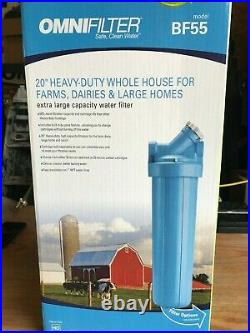
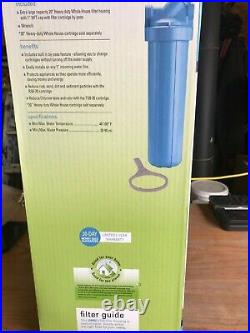
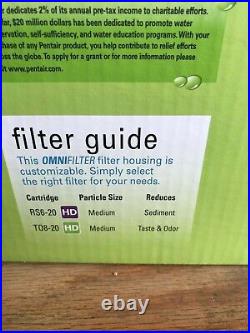
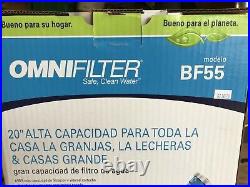
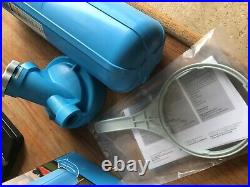
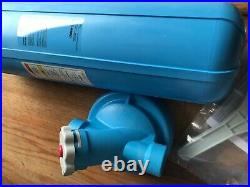
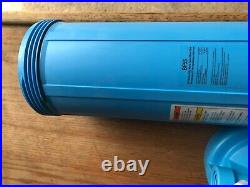

WHOLE-HOUSE WATER FILTER, 20-INCH. BF55 OMNI FILTER HEAVY DUTY EXTRA LARGE NIB. This item is in the category “Home & Garden\Kitchen, Dining & Bar\Small Kitchen Appliances\Water Purification\Water Filters”. The seller is “deanof7″ and is located in this country: US. This item can be shipped to United States, Canada, Mexico, Bermuda.
- Model: BF55
- Type: Water Filter
- Number in Pack: 1
- Compatible Model: omnifilter
- Brand: OmniFilter


Whole-House Water Filter System Catalytic Carbon 1 CU FT Chloramine Removal
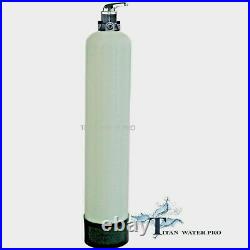

Whole House Water Filter System 1 CU FT Catalytic Carbon with Manual Backwash Valve. Whole-House Filter or Point of Entry. A whole-house filter is installed at a point on the homes water supply plumbing that will result in treatment of all water that travels to any faucet or fixture in the home. A whole-house filter system treats all water traveling to any faucet or fixture in the home. It removes the chemical before it can be ingested, breathed in, or absorbed by the skin during washing or bathing. Backwash on demand (manual). Residential and Commercial Water Filters. Chemistry of Iron Oxidation. A mineral found in soil, iron normally exists in an insoluble oxide form, namely ferric oxide. If acidic or carbon dioxide containing water passes through the soil, the insoluble ferric oxide is reduced to the very soluble ferrous form. When water is pumped from the ground, oxygen from air enters the water and is available for reaction with the ferrous iron. In the presence of oxygen the ferrous form is eventually oxidized to the insoluble ferric form, resulting in familiar red deposits that stain sinks and clothes. In iron removal processes, the insoluble ferric hydroxide comes out of solution and is separated from the water by either filtration or settling. Catalytic carbon accelerates the reaction rate of ferrous to ferric iron dramatically, completely removing the in the relatively short time the water is in contact with the carbon. Under normal conditions, the reaction rate of ferrous to ferric iron is fairly slow, even when excess oxygen is present. This slow reaction rate necessitates the use of large retention tank and sedimentation tanks to allow time for precipitation to occur. A separate filtration step is then required to remove the remaining particulate. In treating iron-laden water, the catalytic properties of the form of granular activated carbon perform quite differently from standard activated carbon. The catalytic properties greatly accelerates the reaction time of iron to an insoluble form. By oxidizing iron from a soluble to less soluble state, catalytic carbon serves to simplify the removal. The resultant increase in reaction rate that occurs by using catalytic carbon allows smaller pieces of equipment to be used. As with all oxidation techniques, oxygen is required but a simple eductor or air injection pump is all that is required. As the reaction occurs, the precipitate is collected on the surface of the carbon, and a secondary filter is not required. Periodic backwashing is performed to remove this iron floc and return the carbon to a usable state. Another benefit of the catalytic carbon is its proven performance in removing hydrogen sulfide (H2S) from water. Many iron-containing waters also contain H2S and same bed of catalytic carbon can be used to remove both. Whole House Water Filtration. This unit includes the following. 9″x 48″ FRP Mineral Tank (Black). Manual Backwash Valve – 1 Pipe Connection. Catalytic Carbon 1 CU FT. Good Economical Whole House Catalytic Carbon Water Filter System. How they work: The Manual valve. It has very few moving parts and easy to use. When you need to backwash a filter, you put it into the backwash cycle for 10 minutes, followed by a rinse for 3 minutes and then back to the service mode. That is all there is to it. Once a week schedule for backwashing is generally sufficient. For a more economical product and ease of use, we recommend you get this rather than opting for unit that does not backwash, read the section on the benefits of backwashing. Benefits and Importance of a Backwash Cycle: As the filter operates in service mode, it accumulates particles in the filter bed. Also since water’s nature is to follow the path of least resistance, after time it begins to create channels through the medium. As channels or holes in the media bed form, water begins to flow around rather than through the medium. This process is called “channeling” and it reduces the effectiveness of the filter considerably. The backwash is accomplished by sending the water down the riser tube from which it enters the filter tank at the bottom. The force of the water is such that it actually lifts the media bed, swirling and tossing the granular medium. The water leaves the filter’s drain line. Particles that were in the bed are washed to drain. The backwash is an intense rinsing and tossing of the medium that lasts for several minutes. In a standard residential filter, a typical backwash lasts about ten minutes. After the backwash, initiate a rinse of the bed during which water flows downward through the medium, up through the distribution tube and out the drain. The purpose of this rinse is to rinse and settle the bed an prepare it for return to service mode. A regular backwash schedule maintains the efficiency of the filter, as well as providing cleaner water. Used or Installed items are not eligible for return. About Us: Titan Water Pro is your “Clean Water Solutions”. The item “Whole-House Water Filter System Catalytic Carbon 1 CU FT Chloramine Removal” is in sale since Thursday, July 1, 2021. This item is in the category “Home & Garden\Kitchen, Dining & Bar\Small Kitchen Appliances\Water Purification\Water Filters”. The seller is “titanwaterpro” and is located in Lancaster, California. This item can be shipped to United States, Canada, United Kingdom, Denmark, Romania, Slovakia, Bulgaria, Czech republic, Finland, Hungary, Latvia, Lithuania, Malta, Estonia, Australia, Greece, Portugal, Cyprus, Slovenia, Japan, China, Sweden, South Korea, Indonesia, Taiwan, South africa, Thailand, Belgium, France, Hong Kong, Ireland, Netherlands, Poland, Spain, Italy, Germany, Austria, Bahamas, Israel, Mexico, New Zealand, Philippines, Singapore, Switzerland, Norway, Saudi arabia, Ukraine, United arab emirates, Qatar, Kuwait, Bahrain, Croatia, Malaysia, Brazil, Chile, Colombia, Costa rica, Panama, Trinidad and tobago, Guatemala, Honduras, Jamaica, Antigua and barbuda, Aruba, Belize, Dominica, Grenada, Saint kitts and nevis, Saint lucia, Montserrat, Turks and caicos islands, Barbados, Bangladesh, Bermuda, Brunei darussalam, Bolivia, Ecuador, Egypt, French guiana, Guernsey, Gibraltar, Guadeloupe, Iceland, Jersey, Jordan, Cambodia, Cayman islands, Liechtenstein, Sri lanka, Luxembourg, Monaco, Macao, Martinique, Maldives, Nicaragua, Oman, Peru, Pakistan, Paraguay, Reunion, Viet nam, Uruguay.
- Model: WH948CATMFV
- Filtration Method: Carbon/Charcoal
- Type: Water Filter
- Compatible Model: Titan
- MPN: WH948CATMFV
- Number of Filtrations: 1
- Catalytic Carbon: Catalytic Carbon
- Brand: Titan Water Pro

Whole-House Water Filter, 20-In


Add to Favorite Sellers. Whole-House Water Filter, 20-In. K Hardware Stores is made up of 4 True Value Hardware Stores that have been in business for over 100 years. K Hardware understands customer service & quality products. Let us help meet your needs while in the comfort of your own home. The item “Whole-House Water Filter, 20-In” is in sale since Friday, April 3, 2020. This item is in the category “Home & Garden\Kitchen, Dining & Bar\Small Kitchen Appliances\Water Purification\Water Filters”. The seller is “khardwarestores” and is located in Idaho Falls, Idaho. This item can be shipped to United States.
- Brand: PENTAIR RESIDENTIAL FILTRATION LLC
- MPN: BF55-S-S06


Whole-House Water Filter System Catalytic Carbon 2 CU FT Fleck 5600 SXT Digital
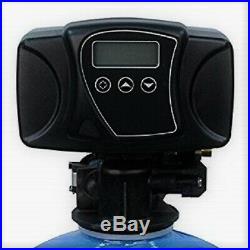

Whole House Water Filter System 2 CU FT Catalytic Carbon with Digitial Fleck 5600. WHOLE HOUSE WATER FILTER (Municipal & Well Water). Whole-House Filter or Point of Entry. A whole-house filter is installed at a point on the homes water supply plumbing that will result in treatment of all water that travels to any faucet or fixture in the home. A whole-house filter system treats all water traveling to any faucet or fixture in the home. It removes the chemical before it can be ingested, breathed in, or absorbed by the skin during washing or bathing. Catalytic Carbon high activity granular activated carbon manufactured by steam activation of select coconut shell charcoal. The Catalytic activity of this activated carbon makes it highly effective for the removal of chloramines from potable water. Its large micropore volume makes it particularly well suited for the removal low molecular weight organic compounds and their chlorinate by-products such as chloroform and other trihalomethanes (THMs). An important feature of this material is its superior mechanical hardness and extensive dedusting during its manufacture ensures an exceptionally clean activated carbon product. Residential and Commercial Water Filters. One of the key characteristics of activated carbon is not only the high surface area available relative to their mass, but also the ability to act as a substrate for other materials. Activated carbons are carefully engineered to have the correct physical properties to optimize their use in this duty, manufactured from coconut shell, coal or wood bases. Many water utilities across the U. Are transitioning to chloramine for disinfection as an alternative to chlorine. This change is in response to stricter U. Environmental Protection Agency regulations on disinfection byproducts (DBPs), which are created when chlorine reacts with organics in water. Chloramine, a combination of chlorine and ammonia, is more stable and does not create DPBs. Removing chloramine at the point of use, however, is more difficult than removing chlorine. Standard granular activated carbon (GAC) and carbon gac products have limited capacity for chloramine reduction. Products known as catalytic or surface-modified activated carbon can provide a solution. In general, the catalytic properties of carbon are measured by the rate at which carbon decomposes hydrogen peroxide. The resulting peroxide number, measured in minutes, estimates the carbons utility in any catalytic application, including chloramine reduction. Based on the comparative results obtained for different mesh size commercial carbons, the efficiency of chloramine reduction is discussed in the terms of peroxide decomposition capacity and further extended to the total life (volume) claims for corresponding GAC carbon. Chemistry of Iron Oxidation. A mineral found in soil, iron normally exists in an insoluble oxide form, namely ferric oxide. If acidic or carbon dioxide containing water passes through the soil, the insoluble ferric oxide is reduced to the very soluble ferrous form. When water is pumped from the ground, oxygen from air enters the water and is available for reaction with the ferrous iron. In the presence of oxygen the ferrous form is eventually oxidized to the insoluble ferric form, resulting in familiar red deposits that stain sinks and clothes. In iron removal processes, the insoluble ferric hydroxide comes out of solution and is separated from the water by either filtration or settling. Catalytic carbon accelerates the reaction rate of ferrous to ferric iron dramatically, completely removing the in the relatively short time the water is in contact with the carbon. Under normal conditions, the reaction rate of ferrous to ferric iron is fairly slow, even when excess oxygen is present. This slow reaction rate necessitates the use of large retention tank and sedimentation tanks to allow time for precipitation to occur. A separate filtration step is then required to remove the remaining particulate. In treating iron-laden water, the catalytic properties of the form of granular activated carbon perform quite differently from standard activated carbon. The catalytic properties greatly accelerates the reaction time of iron to an insoluble form. By oxidizing iron from a soluble to less soluble state, catalytic carbon serves to simplify the removal. The resultant increase in reaction rate that occurs by using catalytic carbon allows smaller pieces of equipment to be used. As with all oxidation techniques, oxygen is required but a simple eductor or air injection pump is all that is required. As the reaction occurs, the precipitate is collected on the surface of the carbon, and a secondary filter is not required. Periodic backwashing is performed to remove this iron floc and return the carbon to a usable state. Another benefit of the catalytic carbon is its proven performance in removing hydrogen sulfide (H2S) from water. Many iron-containing waters also contain H2S and same bed of catalytic carbon can be used to remove both. Similarly, the unique reactive nature of the internal surface of activated carbon means that there is an inherent ability for the promotion of reactions between gases and liquids that would either proceed too slowly or generate uneconomic yields of final product. This is achieved without the need for the addition of a chemical reagent to the activated carbon and often true catalysis proceeds, without degradation of the surface or adsorbent. Whole House Water Filtration. This unit includes the following. 1252 FRP Mineral Tank (Color Varies). Catalytic Carbon 2 Cu Ft. Fleck 5600SXT Digital Backwash Control Unit. Good Economical Whole House Catalytic Carbon Water Filter System. Hydrogen sulfide concentrations exceeding 7 to 10 ppm can be removed by injecting an oxidizing chemical such as household bleach followed up by filtration. The oxidizing chemical should enter the water upstream from the storage or mixing tank to provide at least 30-45 minutes of contact time between the chemical and water. The length of length of the holding time is a function of the chemical dosage, tank configuration and water temperature. Sulfur particles can then be removed using a sediment filter and the excess chlorine can be removed by activated carbon filtration. If test results indicate that bacterial contamination is occurring, shock chlorination or disinfection is the most widely suggested method for initial treatment. Shock chlorination (disinfection) is the one-time introduction of a strong solution into the entire water distribution system well, pump, distribution pipeline, etc. When to Shock Disinfect the Well. Shock chlorination (disinfection) is recommended when lab results indicate a presence of bacteria upon completion of a new well or after pump replacement or repair, when the distribution system is opened for repairs or maintenance, following contamination by flood water, to control iron and sulfur bacteria. Shock chlorination (disinfection) is recommended in these circumstances to ensure that bacterial contamination is controlled. This system should be used where low to moderate ferrous (dissolved) iron or hydrogen sulfide contamination is known. This filter is most effective where iron and hydrogen sulfide levels are less then 5 ppm. Best removal rates are achieved where pH is between 6.5 and 8.5 and where water contains some dissolved oxygen. Selecting a water treatment system begins with water test results from a certified drinking water testing lab. Such test results should be compared to the water treatment product specifications to ensure that the treatment system being considered is designed to treat. The substances you want to treat. In the concentrations at which they exist in your water. There is no one-size-fits-all water treatment technology that addresses all water quality problems. In some cases, one treatment technology may meet all your specific needs. In other cases, you may need a treatment traina series of treatment technologies in a sequence that treat one or more water quality problems. Again, when considering water treatment, use your lab test results as a guide and make sure the technology you are considering is designed to treat the problematic substances in your water. Used or Installed items are not eligible for return. Titan Water Pro is your “Clean Water Solutions”. The item “Whole-House Water Filter System Catalytic Carbon 2 CU FT Fleck 5600 SXT Digital” is in sale since Friday, November 29, 2019. This item is in the category “Home & Garden\Kitchen, Dining & Bar\Small Kitchen Appliances\Water Purification\Water Filters”. The seller is “titanwaterpro” and is located in Lancaster, California. This item can be shipped to United States, Canada, United Kingdom, Denmark, Romania, Slovakia, Bulgaria, Czech republic, Finland, Hungary, Latvia, Lithuania, Malta, Estonia, Australia, Greece, Portugal, Cyprus, Slovenia, Japan, China, Sweden, South Korea, Indonesia, Taiwan, South africa, Thailand, Belgium, France, Hong Kong, Ireland, Netherlands, Poland, Spain, Italy, Germany, Austria, Bahamas, Israel, Mexico, New Zealand, Singapore, Switzerland, Norway, Saudi arabia, Ukraine, United arab emirates, Qatar, Kuwait, Bahrain, Croatia, Malaysia, Brazil, Chile, Colombia, Costa rica, Panama, Trinidad and tobago, Guatemala, Honduras, Jamaica, Barbados, Bangladesh, Bermuda, Brunei darussalam, Bolivia, Egypt, French guiana, Gibraltar, Guadeloupe, Iceland, Jordan, Cambodia, Cayman islands, Sri lanka, Luxembourg, Maldives, Nicaragua, Oman, Peru, Pakistan, Paraguay, Viet nam, Uruguay.
- Model: WHCC1252T
- Filtration Method: Carbon/Charcoal
- Power: 110V
- water filter: POE Water Filter
- Iron Removal: H2S
- Chloramine Removal: Chlorine Removal
- Type: Water Filter
- catalytic carbon: frp tank
- Number of Filtrations: 1
- Color: Multi-Color
- MPN: TWP188WH
- Brand: Fleck
- Suitable For: Commercial

Whole-House Water Filter System Catalytic Carbon 2 CU FT AQT-56FT
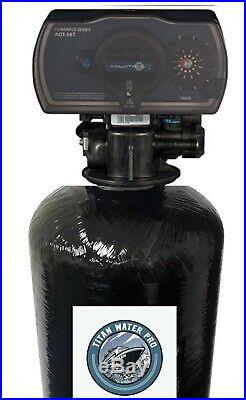

Whole House Water Filter System 2 CU FT Catalytic Carbon with Aquatrol FT56 Backwash Valve. WHOLE HOUSE WATER FILTER. Whole-House Filter or Point of Entry. A whole-house filter is installed at a point on the homes water supply plumbing that will result in treatment of all water that travels to any faucet or fixture in the home. A whole-house filter system treats all water traveling to any faucet or fixture in the home. It removes the chemical before it can be ingested, breathed in, or absorbed by the skin during washing or bathing. Catalytic Carbon high activity granular activated carbon manufactured by steam activation of select coconut shell charcoal. The Catalytic activity of this activated carbon makes it highly effective for the removal of chloramines from potable water. Its large micropore volume makes it particularly well suited for the removal low molecular weight organic compounds and their chlorinate by-products such as chloroform and other trihalomethanes (THMs). An important feature of this material is its superior mechanical hardness and extensive dedusting during its manufacture ensures an exceptionally clean activated carbon product. Residential and Commercial Water Filters. One of the key characteristics of activated carbon is not only the high surface area available relative to their mass, but also the ability to act as a substrate for other materials. Activated carbons are carefully engineered to have the correct physical properties to optimize their use in this duty, manufactured from coconut shell, coal or wood bases. Many water utilities across the U. Are transitioning to chloramine for disinfection as an alternative to chlorine. This change is in response to stricter U. Environmental Protection Agency regulations on disinfection byproducts (DBPs), which are created when chlorine reacts with organics in water. Chloramine, a combination of chlorine and ammonia, is more stable and does not create DPBs. Removing chloramine at the point of use, however, is more difficult than removing chlorine. Standard granular activated carbon (GAC) and carbon gac products have limited capacity for chloramine reduction. Products known as catalytic or surface-modified activated carbon can provide a solution. In general, the catalytic properties of carbon are measured by the rate at which carbon decomposes hydrogen peroxide. The resulting peroxide number, measured in minutes, estimates the carbons utility in any catalytic application, including chloramine reduction. Based on the comparative results obtained for different mesh size commercial carbons, the efficiency of chloramine reduction is discussed in the terms of peroxide decomposition capacity and further extended to the total life (volume) claims for corresponding GAC carbon. Chemistry of Iron Oxidation. A mineral found in soil, iron normally exists in an insoluble oxide form, namely ferric oxide. If acidic or carbon dioxide containing water passes through the soil, the insoluble ferric oxide is reduced to the very soluble ferrous form. When water is pumped from the ground, oxygen from air enters the water and is available for reaction with the ferrous iron. In the presence of oxygen the ferrous form is eventually oxidized to the insoluble ferric form, resulting in familiar red deposits that stain sinks and clothes. In iron removal processes, the insoluble ferric hydroxide comes out of solution and is separated from the water by either filtration or settling. Catalytic carbon accelerates the reaction rate of ferrous to ferric iron dramatically, completely removing the in the relatively short time the water is in contact with the carbon. Under normal conditions, the reaction rate of ferrous to ferric iron is fairly slow, even when excess oxygen is present. This slow reaction rate necessitates the use of large retention tank and sedimentation tanks to allow time for precipitation to occur. A separate filtration step is then required to remove the remaining particulate. In treating iron-laden water, the catalytic properties of the form of granular activated carbon perform quite differently from standard activated carbon. The catalytic properties greatly accelerates the reaction time of iron to an insoluble form. By oxidizing iron from a soluble to less soluble state, catalytic carbon serves to simplify the removal. The resultant increase in reaction rate that occurs by using catalytic carbon allows smaller pieces of equipment to be used. As with all oxidation techniques, oxygen is required but a simple eductor or air injection pump is all that is required. As the reaction occurs, the precipitate is collected on the surface of the carbon, and a secondary filter is not required. Periodic backwashing is performed to remove this iron floc and return the carbon to a usable state. Another benefit of the catalytic carbon is its proven performance in removing hydrogen sulfide (H2S) from water. Many iron-containing waters also contain H2S and same bed of catalytic carbon can be used to remove both. Similarly, the unique reactive nature of the internal surface of activated carbon means that there is an inherent ability for the promotion of reactions between gases and liquids that would either proceed too slowly or generate uneconomic yields of final product. This is achieved without the need for the addition of a chemical reagent to the activated carbon and often true catalysis proceeds, without degradation of the surface or adsorbent. Whole House Water Filtration. This unit includes the following. 1252 FRP Mineral Tank (Color Varies). Aquatrol 56FT Auto Timer Valve 110V -1 Yoke. Catalytic Carbon 2 Cu Ft. Good Economical Whole House Catalytic Carbon Water Filter System. Hydrogen sulfide concentrations exceeding 7 to 10 ppm can be removed by injecting an oxidizing chemical such as household bleach followed up by filtration. The oxidizing chemical should enter the water upstream from the storage or mixing tank to provide at least 30-45 minutes of contact time between the chemical and water. The length of length of the holding time is a function of the chemical dosage, tank configuration and water temperature. Sulfur particles can then be removed using a sediment filter and the excess chlorine can be removed by activated carbon filtration. If test results indicate that bacterial contamination is occurring, shock chlorination or disinfection is the most widely suggested method for initial treatment. Shock chlorination (disinfection) is the one-time introduction of a strong solution into the entire water distribution system well, pump, distribution pipeline, etc. When to Shock Disinfect the Well. Shock chlorination (disinfection) is recommended when lab results indicate a presence of bacteria upon completion of a new well or after pump replacement or repair, when the distribution system is opened for repairs or maintenance, following contamination by flood water, to control iron and sulfur bacteria. Shock chlorination (disinfection) is recommended in these circumstances to ensure that bacterial contamination is controlled. This system should be used where low to moderate ferrous (dissolved) iron or hydrogen sulfide contamination is known. This filter is most effective where iron and hydrogen sulfide levels are less then 5 ppm. Best removal rates are achieved where pH is between 6.5 and 8.5 and where water contains some dissolved oxygen. Selecting a water treatment system begins with water test results from a certified drinking water testing lab. Such test results should be compared to the water treatment product specifications to ensure that the treatment system being considered is designed to treat. The substances you want to treat. In the concentrations at which they exist in your water. There is no one-size-fits-all water treatment technology that addresses all water quality problems. In some cases, one treatment technology may meet all your specific needs. In other cases, you may need a treatment traina series of treatment technologies in a sequence that treat one or more water quality problems. Again, when considering water treatment, use your lab test results as a guide and make sure the technology you are considering is designed to treat the problematic substances in your water. Used or Installed items are not eligible for return. Titan Water Pro is your “Clean Water Solutions”. The item “Whole-House Water Filter System Catalytic Carbon 2 CU FT AQT-56FT” is in sale since Monday, October 28, 2019. This item is in the category “Home & Garden\Kitchen, Dining & Bar\Small Kitchen Appliances\Water Purification\Water Filters”. The seller is “titanwaterpro” and is located in Lancaster, California. This item can be shipped to United States, Canada, United Kingdom, Denmark, Romania, Slovakia, Bulgaria, Czech republic, Finland, Hungary, Latvia, Lithuania, Malta, Estonia, Australia, Greece, Portugal, Cyprus, Slovenia, Japan, China, Sweden, South Korea, Indonesia, Taiwan, South africa, Thailand, Belgium, France, Hong Kong, Ireland, Netherlands, Poland, Spain, Italy, Germany, Austria, Bahamas, Israel, Mexico, New Zealand, Singapore, Switzerland, Norway, Saudi arabia, Ukraine, United arab emirates, Qatar, Kuwait, Bahrain, Croatia, Malaysia, Brazil, Chile, Colombia, Costa rica, Panama, Trinidad and tobago, Guatemala, Honduras, Jamaica, Barbados, Bangladesh, Bermuda, Brunei darussalam, Bolivia, Egypt, French guiana, Gibraltar, Guadeloupe, Iceland, Jordan, Cambodia, Cayman islands, Sri lanka, Luxembourg, Maldives, Nicaragua, Oman, Peru, Pakistan, Paraguay, Viet nam, Uruguay.
- Model: WHCC1252T
- Filtration Method: Carbon/Charcoal
- Power: 110V
- water filter: POE Water Filter
- Iron Removal: H2S
- Chloramine Removal: Chlorine Removal
- Type: Water Filter
- catalytic carbon: frp tank
- Number of Filtrations: 1
- Color: Multi-Color
- MPN: TWP188WH
- Brand: Titan Water Pro


Whole-House Water Filter System Catalytic Carbon 1.5 CU FT Chloramine Removal
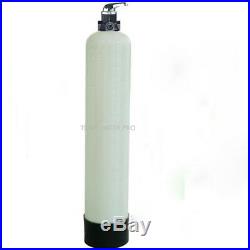

Whole House Water Filter System 1.5 CU FT Catalytic Carbon with Manual Backwash Valve. Whole-House Filter or Point of Entry. A whole-house filter is installed at a point on the homes water supply plumbing that will result in treatment of all water that travels to any faucet or fixture in the home. A whole-house filter system treats all water traveling to any faucet or fixture in the home. It removes the chemical before it can be ingested, breathed in, or absorbed by the skin during washing or bathing. Backwash on demand (manual). Residential and Commercial Water Filters. Chemistry of Iron Oxidation. A mineral found in soil, iron normally exists in an insoluble oxide form, namely ferric oxide. If acidic or carbon dioxide containing water passes through the soil, the insoluble ferric oxide is reduced to the very soluble ferrous form. When water is pumped from the ground, oxygen from air enters the water and is available for reaction with the ferrous iron. In the presence of oxygen the ferrous form is eventually oxidized to the insoluble ferric form, resulting in familiar red deposits that stain sinks and clothes. In iron removal processes, the insoluble ferric hydroxide comes out of solution and is separated from the water by either filtration or settling. Catalytic carbon accelerates the reaction rate of ferrous to ferric iron dramatically, completely removing the in the relatively short time the water is in contact with the carbon. Under normal conditions, the reaction rate of ferrous to ferric iron is fairly slow, even when excess oxygen is present. This slow reaction rate necessitates the use of large retention tank and sedimentation tanks to allow time for precipitation to occur. A separate filtration step is then required to remove the remaining particulate. In treating iron-laden water, the catalytic properties of the form of granular activated carbon perform quite differently from standard activated carbon. The catalytic properties greatly accelerates the reaction time of iron to an insoluble form. By oxidizing iron from a soluble to less soluble state, catalytic carbon serves to simplify the removal. The resultant increase in reaction rate that occurs by using catalytic carbon allows smaller pieces of equipment to be used. As with all oxidation techniques, oxygen is required but a simple eductor or air injection pump is all that is required. As the reaction occurs, the precipitate is collected on the surface of the carbon, and a secondary filter is not required. Periodic backwashing is performed to remove this iron floc and return the carbon to a usable state. Another benefit of the catalytic carbon is its proven performance in removing hydrogen sulfide (H2S) from water. Many iron-containing waters also contain H2S and same bed of catalytic carbon can be used to remove both. Whole House Water Filtration. This unit includes the following. 10″x 54″ FRP Mineral Tank (Black, blue or natural Varies). Catalytic Carbon 1.5 CU FT. Good Economical Whole House Catalytic Carbon Water Filter System. Manual Valve: How they work: The Manual valve. It has very few moving parts and easy to use. When you need to backwash a filter, you put it into the backwash cycle for 10 minutes, followed by a rinse for 3 minutes and then back to the service mode. That is all there is to it. Once a week schedule for backwashing is generally sufficient. For a more economical product and ease of use, we recommend you get this rather than opting for unit that does not backwash, read the section on the benefits of backwashing. Benefits and Importance of a Backwash Cycle: As the filter operates in service mode, it accumulates particles in the filter bed. Also since water’s nature is to follow the path of least resistance, after time it begins to create channels through the medium. As channels or holes in the media bed form, water begins to flow around rather than through the medium. This process is called “channeling” and it reduces the effectiveness of the filter considerably. The backwash is accomplished by sending the water down the riser tube from which it enters the filter tank at the bottom. The force of the water is such that it actually lifts the media bed, swirling and tossing the granular medium. The water leaves the filter’s drain line. Particles that were in the bed are washed to drain. The backwash is an intense rinsing and tossing of the medium that lasts for several minutes. In a standard residential filter, a typical backwash lasts about ten minutes. After the backwash, initiate a rinse of the bed during which water flows downward through the medium, up through the distribution tube and out the drain. The purpose of this rinse is to rinse and settle the bed an prepare it for return to service mode. A regular backwash schedule maintains the efficiency of the filter, as well as providing cleaner water. Used or Installed items are not eligible for return. About Us: Pacific is your “Clean Water Solutions”. The item “Whole-House Water Filter System Catalytic Carbon 1.5 CU FT Chloramine Removal” is in sale since Friday, December 23, 2016. This item is in the category “Home & Garden\Kitchen, Dining & Bar\Small Kitchen Appliances\Water Purification\Water Filters”. The seller is “pacificwatersystems” and is located in Lancaster, California. This item can be shipped to United States, Canada, United Kingdom, Denmark, Romania, Slovakia, Bulgaria, Czech republic, Finland, Hungary, Latvia, Lithuania, Malta, Estonia, Australia, Greece, Portugal, Cyprus, Slovenia, Japan, China, Sweden, South Korea, Indonesia, Taiwan, South africa, Thailand, Belgium, France, Hong Kong, Ireland, Netherlands, Poland, Spain, Italy, Germany, Austria, Bahamas, Israel, Mexico, New Zealand, Philippines, Singapore, Switzerland, Norway, Saudi arabia, Ukraine, United arab emirates, Qatar, Kuwait, Bahrain, Croatia, Malaysia, Brazil, Chile, Colombia, Costa rica, Panama, Trinidad and tobago, Guatemala, Honduras, Jamaica, Antigua and barbuda, Aruba, Belize, Dominica, Grenada, Saint kitts and nevis, Saint lucia, Turks and caicos islands, Barbados, Bangladesh, Bermuda, Brunei darussalam, Bolivia, Egypt, French guiana, Gibraltar, Guadeloupe, Iceland, Jordan, Cambodia, Cayman islands, Sri lanka, Luxembourg, Maldives, Nicaragua, Oman, Peru, Pakistan, Paraguay, Viet nam, Uruguay.
- Model: WHMJ948
- Filtration Method: UF Ultra Filtration
- Type: Whole House Filter System
- Color: Multi-Color
- MPN: TWP188WH
- Brand: Pacific

Whole-House Water Filter System Catalytic Carbon 1 CU FT Fleck 5600
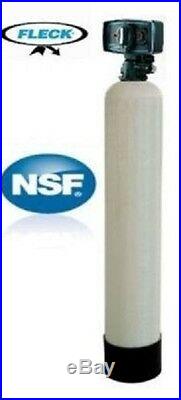

Whole House Water Filter System 1 CU FT Catalytic Carbon with Fleck 5600 Backwash Control Valve. WHOLE HOUSE WATER FILTER. Whole-House Filter or Point of Entry. A whole-house filter is installed at a point on the homes water supply plumbing that will result in treatment of all water that travels to any faucet or fixture in the home. A whole-house filter system treats all water traveling to any faucet or fixture in the home. It removes the chemical before it can be ingested, breathed in, or absorbed by the skin during washing or bathing. Catalytic Carbon high activity granular activated carbon manufactured by steam activation of select coconut shell charcoal. The Catalytic activity of this activated carbon makes it highly effective for the removal of chloramines from potable water. Its large micropore volume makes it particularly well suited for the removal low molecular weight organic compounds and their chlorinate by-products such as chloroform and other trihalomethanes (THMs). An important feature of this material is its superior mechanical hardness and extensive dedusting during its manufacture ensures an exceptionally clean activated carbon product. Residential and Commercial Water Filters. One of the key characteristics of activated carbon is not only the high surface area available relative to their mass, but also the ability to act as a substrate for other materials. Activated carbons Carbons are carefully engineered to have the correct physical properties to optimize their use in this duty, manufactured from coconut shell, coal or wood bases. Many water utilities across the U. Are transitioning to chloramine for disinfection as an alternative to chlorine. This change is in response to stricter U. Environmental Protection Agency regulations on disinfection byproducts (DBPs), which are created when chlorine reacts with organics in water. Chloramine, a combination of chlorine and ammonia, is more stable and does not create DPBs. Removing chloramine at the point of use, however, is more difficult than removing chlorine. Standard granular activated carbon (GAC) and carbon gac products have limited capacity for chloramine reduction. Products known as catalytic or surface-modified activated carbon can provide a solution. In general, the catalytic properties of carbon are measured by the rate at which carbon decomposes hydrogen peroxide. The resulting peroxide number, measured in minutes, estimates the carbons utility in any catalytic application, including chloramine reduction. Based on the comparative results obtained for different mesh size commercial carbons, the efficiency of chloramine reduction is discussed in the terms of peroxide decomposition capacity and further extended to the total life (volume) claims for corresponding GAC carbon. Chemistry of Iron Oxidation. A mineral found in soil, iron normally exists in an insoluble oxide form, namely ferric oxide. If acidic or carbon dioxide containing water passes through the soil, the insoluble ferric oxide is reduced to the very soluble ferrous form. When water is pumped from the ground, oxygen from air enters the water and is available for reaction with the ferrous iron. In the presence of oxygen the ferrous form is eventually oxidized to the insoluble ferric form, resulting in familiar red deposits that stain sinks and clothes. In iron removal processes, the insoluble ferric hydroxide comes out of solution and is separated from the water by either filtration or settling. Catalytic carbon accelerates the reaction rate of ferrous to ferric iron dramatically, completely removing the in the relatively short time the water is in contact with the carbon. Under normal conditions, the reaction rate of ferrous to ferric iron is fairly slow, even when excess oxygen is present. This slow reaction rate necessitates the use of large retention tank and sedimentation tanks to allow time for precipitation to occur. A separate filtration step is then required to remove the remaining particulate. In treating iron-laden water, the catalytic properties of the form of granular activated carbon perform quite differently from standard activated carbon. The catalytic properties greatly accelerates the reaction time of iron to an insoluble form. By oxidizing iron from a soluble to less soluble state, catalytic carbon serves to simplify the removal. The resultant increase in reaction rate that occurs by using catalytic carbon allows smaller pieces of equipment to be used. As with all oxidation techniques, oxygen is required but a simple eductor or air injection pump is all that is required. As the reaction occurs, the precipitate is collected on the surface of the carbon, and a secondary filter is not required. Periodic backwashing is performed to remove this iron floc and return the carbon to a usable state. Another benefit of the catalytic carbon is its proven performance in removing hydrogen sulfide (H2S) from water. Many iron-containing waters also contain H2S and same bed of catalytic carbon can be used to remove both. Similarly, the unique reactive nature of the internal surface of activated carbon means that there is an inherent ability for the promotion of reactions between gases and liquids that would either proceed too slowly or generate uneconomic yields of final product. This is achieved without the need for the addition of a chemical reagent to the activated carbon and often true catalysis proceeds, without degradation of the surface or adsorbent. Whole House Water Filtration. This unit includes the following. 9″x 48″ FRP Mineral Tank (Black or Blue). Fleck 5600 Timer Valve 110V. Good Economical Whole House Catalytic Carbon Water Filter System. Used or Installed items are not eligible for return. Titan Water Pro is your “Clean Water Solutions”. Track Page Views With. Auctiva’s FREE Counter. Used or installed items, items removed from original sealed packages will not be accepted for return. Any damaged item, please send us photo of the damaged item. The item “Whole-House Water Filter System Catalytic Carbon 1 CU FT Fleck 5600″ is in sale since Monday, August 7, 2017. This item is in the category “Home & Garden\Kitchen, Dining & Bar\Small Kitchen Appliances\Water Purification\Water Filters”. The seller is “titanwaterpro” and is located in Lancaster, California. This item can be shipped to United States, Canada, United Kingdom, Denmark, Romania, Slovakia, Bulgaria, Czech republic, Finland, Hungary, Latvia, Lithuania, Malta, Estonia, Australia, Greece, Portugal, Cyprus, Slovenia, Japan, China, Sweden, South Korea, Indonesia, Taiwan, South africa, Thailand, Belgium, France, Hong Kong, Ireland, Netherlands, Poland, Spain, Italy, Germany, Austria, Bahamas, Israel, Mexico, New Zealand, Philippines, Singapore, Switzerland, Norway, Saudi arabia, Ukraine, United arab emirates, Qatar, Kuwait, Bahrain, Croatia, Malaysia, Brazil, Chile, Colombia, Costa rica, Panama, Trinidad and tobago, Guatemala, Honduras, Jamaica, Viet nam, Uruguay, Antigua and barbuda, Aruba, Belize, Dominica, Grenada, Saint kitts and nevis, Saint lucia, Turks and caicos islands, Barbados, Bangladesh, Bermuda, Brunei darussalam, Bolivia, Egypt, French guiana, Gibraltar, Guadeloupe, Iceland, Jordan, Cambodia, Cayman islands, Sri lanka, Luxembourg, Maldives, Nicaragua, Oman, Peru, Pakistan, Paraguay.
- Type: Whole House Filter System
- Brand: Titan Water Pro
- Filtration Method: Carbon/Charcoal
- Power: 110V
- Color: Multi-Color
- Model: WHMJ948T
- MPN: TWP188WH
- Catalytic Carbon: Jacobi Catalytic Carbon
- water filter: POE Water Filter
- Iron Removal: Hydrogen
- Chloramine Removal: Chlorine Removal

Whole-House Water Filtration System Scale Prevention Filter Cartridges Oneflow +
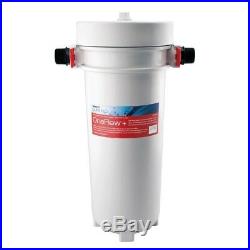
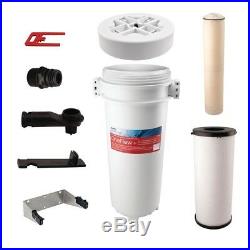
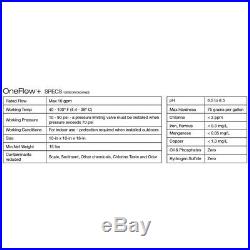
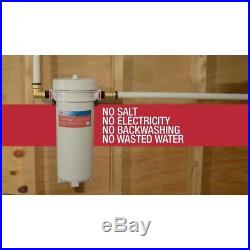
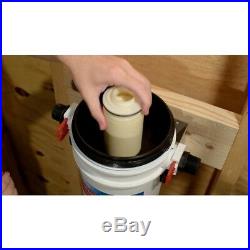

Whole-House Water Filtration System Scale Prevention Filter Cartridges Oneflow +. This system is designed to reduce scale, sediment, other chemicals, chlorine taste and odors providing great tasting water at every tap in a home. It has a compact design with 1 in. NPT inlet and outlet connections, allows for easy installation and is virtually maintenance free. It is environmentally friendly with no electricity needed, no wasted water or drain required. This system includes a pressure relief valve and multifunction tool for easy cartridge replacements. Filter, Hardware, Installation kit. Maximum feed water pressure (psi). Maximum feed water temperature (F). Maximum filtered water flow gallons per min. Minimum feed water pressure (psi). Minimum feed water temperature (F). Number of filters included. Water Filtration System Type. Our stock all ships from our US-based warehouses. For Electrical Items: These products are manufactured according to the specifications of the US Electrical Standards and codes. We assume no responsibility if the item malfunctions or causes an accident because you tried to use the product with foreign electrical standards. The use of these items with a converter or other voltage transforming device is at your own risk. Please Note: Products are designed and rated for use in the US using a 110-120 Volt power source. With or without a transformer, this product is not recommended for use outside the US. The item “Whole-House Water Filtration System Scale Prevention Filter Cartridges Oneflow +” is in sale since Monday, May 7, 2018. This item is in the category “Home & Garden\Home Improvement\Plumbing & Fixtures\Water Filters”. The seller is “besthomesupplies” and is located in Multiple Locations. This item can be shipped to United States, Canada, United Kingdom, Denmark, Romania, Slovakia, Bulgaria, Czech republic, Finland, Hungary, Latvia, Lithuania, Malta, Estonia, Australia, Greece, Portugal, Cyprus, Slovenia, Japan, China, Sweden, South Korea, Indonesia, Taiwan, South africa, Thailand, Belgium, France, Hong Kong, Ireland, Netherlands, Poland, Spain, Italy, Germany, Austria, Bahamas, Israel, Mexico, New Zealand, Singapore, Switzerland, Norway, Saudi arabia, Ukraine, United arab emirates, Qatar, Kuwait, Bahrain, Croatia, Malaysia, Brazil, Chile, Colombia, Costa rica, Panama, Trinidad and tobago, Guatemala, Honduras, Jamaica, Viet nam, Uruguay.
- Brand: Watts
- MPN: OFPSYS
- ISBN: Does not apply
- UPC: 098268085082
- EAN: 098268085082
- Type: Carbon Block
- Bundle Listing: No

Whole-House Water Filter System Catalytic Carbon 2 CU FT Backwash Timer Valve
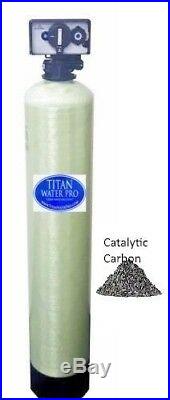

Whole House Water Filter System 2 CU FT Catalytic Carbon with Filtrol FM-20 Backwash Valve. WHOLE HOUSE WATER FILTER. Whole-House Filter or Point of Entry. A whole-house filter is installed at a point on the homes water supply plumbing that will result in treatment of all water that travels to any faucet or fixture in the home. A whole-house filter system treats all water traveling to any faucet or fixture in the home. It removes the chemical before it can be ingested, breathed in, or absorbed by the skin during washing or bathing. Catalytic Carbon high activity granular activated carbon manufactured by steam activation of select coconut shell charcoal. The Catalytic activity of this activated carbon makes it highly effective for the removal of chloramines from potable water. Its large micropore volume makes it particularly well suited for the removal low molecular weight organic compounds and their chlorinate by-products such as chloroform and other trihalomethanes (THMs). An important feature of this material is its superior mechanical hardness and extensive dedusting during its manufacture ensures an exceptionally clean activated carbon product. Residential and Commercial Water Filters. One of the key characteristics of activated carbon is not only the high surface area available relative to their mass, but also the ability to act as a substrate for other materials. Activated carbons are carefully engineered to have the correct physical properties to optimize their use in this duty, manufactured from coconut shell, coal or wood bases. Many water utilities across the U. Are transitioning to chloramine for disinfection as an alternative to chlorine. This change is in response to stricter U. Environmental Protection Agency regulations on disinfection byproducts (DBPs), which are created when chlorine reacts with organics in water. Chloramine, a combination of chlorine and ammonia, is more stable and does not create DPBs. Removing chloramine at the point of use, however, is more difficult than removing chlorine. Standard granular activated carbon (GAC) and carbon gac products have limited capacity for chloramine reduction. Products known as catalytic or surface-modified activated carbon can provide a solution. In general, the catalytic properties of carbon are measured by the rate at which carbon decomposes hydrogen peroxide. The resulting peroxide number, measured in minutes, estimates the carbons utility in any catalytic application, including chloramine reduction. Based on the comparative results obtained for different mesh size commercial carbons, the efficiency of chloramine reduction is discussed in the terms of peroxide decomposition capacity and further extended to the total life (volume) claims for corresponding GAC carbon. Chemistry of Iron Oxidation. A mineral found in soil, iron normally exists in an insoluble oxide form, namely ferric oxide. If acidic or carbon dioxide containing water passes through the soil, the insoluble ferric oxide is reduced to the very soluble ferrous form. When water is pumped from the ground, oxygen from air enters the water and is available for reaction with the ferrous iron. In the presence of oxygen the ferrous form is eventually oxidized to the insoluble ferric form, resulting in familiar red deposits that stain sinks and clothes. In iron removal processes, the insoluble ferric hydroxide comes out of solution and is separated from the water by either filtration or settling. Catalytic carbon accelerates the reaction rate of ferrous to ferric iron dramatically, completely removing the in the relatively short time the water is in contact with the carbon. Under normal conditions, the reaction rate of ferrous to ferric iron is fairly slow, even when excess oxygen is present. This slow reaction rate necessitates the use of large retention tank and sedimentation tanks to allow time for precipitation to occur. A separate filtration step is then required to remove the remaining particulate. In treating iron-laden water, the catalytic properties of the form of granular activated carbon perform quite differently from standard activated carbon. The catalytic properties greatly accelerates the reaction time of iron to an insoluble form. By oxidizing iron from a soluble to less soluble state, catalytic carbon serves to simplify the removal. The resultant increase in reaction rate that occurs by using catalytic carbon allows smaller pieces of equipment to be used. As with all oxidation techniques, oxygen is required but a simple eductor or air injection pump is all that is required. As the reaction occurs, the precipitate is collected on the surface of the carbon, and a secondary filter is not required. Periodic backwashing is performed to remove this iron floc and return the carbon to a usable state. Another benefit of the catalytic carbon is its proven performance in removing hydrogen sulfide (H2S) from water. Many iron-containing waters also contain H2S and same bed of catalytic carbon can be used to remove both. Similarly, the unique reactive nature of the internal surface of activated carbon means that there is an inherent ability for the promotion of reactions between gases and liquids that would either proceed too slowly or generate uneconomic yields of final product. This is achieved without the need for the addition of a chemical reagent to the activated carbon and often true catalysis proceeds, without degradation of the surface or adsorbent. Whole House Water Filtration. This unit includes the following. 1252 FRP Mineral Tank (Color Varies). Filtrol FM-20 Auto Timer Valve 110V -1 Yoke. Catalytic Carbon 2 Cu Ft. Good Economical Whole House Catalytic Carbon Water Filter System. Hydrogen sulfide concentrations exceeding 7 to 10 ppm can be removed by injecting an oxidizing chemical such as household bleach followed up by filtration. The oxidizing chemical should enter the water upstream from the storage or mixing tank to provide at least 30-45 minutes of contact time between the chemical and water. The length of length of the holding time is a function of the chemical dosage, tank configuration and water temperature. Sulfur particles can then be removed using a sediment filter and the excess chlorine can be removed by activated carbon filtration. If test results indicate that bacterial contamination is occurring, shock chlorination or disinfection is the most widely suggested method for initial treatment. Shock chlorination (disinfection) is the one-time introduction of a strong solution into the entire water distribution system well, pump, distribution pipeline, etc. When to Shock Disinfect the Well. Shock chlorination (disinfection) is recommended when lab results indicate a presence of bacteria upon completion of a new well or after pump replacement or repair, when the distribution system is opened for repairs or maintenance, following contamination by flood water, to control iron and sulfur bacteria. Shock chlorination (disinfection) is recommended in these circumstances to ensure that bacterial contamination is controlled. This system should be used where low to moderate ferrous (dissolved) iron or hydrogen sulfide contamination is known. This filter is most effective where iron and hydrogen sulfide levels are less then 5 ppm. Best removal rates are achieved where pH is between 6.5 and 8.5 and where water contains some dissolved oxygen. Selecting a water treatment system begins with water test results from a certified drinking water testing lab. Such test results should be compared to the water treatment product specifications to ensure that the treatment system being considered is designed to treat. The substances you want to treat. In the concentrations at which they exist in your water. There is no one-size-fits-all water treatment technology that addresses all water quality problems. In some cases, one treatment technology may meet all your specific needs. In other cases, you may need a treatment traina series of treatment technologies in a sequence that treat one or more water quality problems. Again, when considering water treatment, use your lab test results as a guide and make sure the technology you are considering is designed to treat the problematic substances in your water. Used or Installed items are not eligible for return. Titan Water Pro is your “Clean Water Solutions”. Track Page Views With. Auctiva’s FREE Counter. The item “Whole-House Water Filter System Catalytic Carbon 2 CU FT Backwash Timer Valve” is in sale since Wednesday, October 17, 2018. This item is in the category “Home & Garden\Kitchen, Dining & Bar\Small Kitchen Appliances\Water Purification\Water Filters”. The seller is “titanwaterpro” and is located in Canyon Country, California. This item can be shipped to United States, Canada, United Kingdom, Denmark, Romania, Slovakia, Bulgaria, Czech republic, Finland, Hungary, Latvia, Lithuania, Malta, Estonia, Australia, Greece, Portugal, Cyprus, Slovenia, Japan, China, Sweden, South Korea, Indonesia, Taiwan, South africa, Thailand, Belgium, France, Hong Kong, Ireland, Netherlands, Poland, Spain, Italy, Germany, Austria, Israel, Mexico, New Zealand, Singapore, Switzerland, Norway, Saudi arabia, Ukraine, United arab emirates, Qatar, Kuwait, Bahrain, Croatia, Malaysia, Brazil, Chile, Colombia, Costa rica, Panama, Trinidad and tobago, Guatemala, Honduras, Jamaica, Bahamas, Viet nam, Uruguay.
- Power: 110V
- water filter: POE Water Filter
- Iron Removal: H2S
- Chloramine Removal: Chlorine Removal
- Model: WHCC1252T
- Filtration Method: Carbon/Charcoal
- Type: Water Filter
- Color: Multi-Color
- MPN: TWP188WH
- Brand: Titan Water Pro
- Number of Filtrations: 1
- catalytic carbon: frp tank
